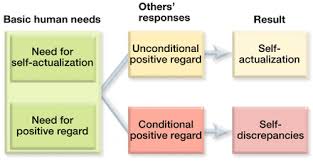Unconditional positive regard is a term coined by humanistic psychologist Carl Rogers and is an essential component of person-centered therapy. It refers to the therapist’s attitude of complete acceptance, nonjudgment, and support toward the client, regardless of what the client says or does.
In therapy, unconditional positive regard creates a safe and nurturing environment where clients feel valued and accepted for who they are. The therapist demonstrates genuine care and empathy, withholding any personal judgments or evaluations. This attitude allows clients to explore their thoughts, feelings, and experiences without fear of criticism or rejection.
The concept of unconditional positive regard is grounded in the belief that individuals have an innate drive for growth and self-actualization. By providing an atmosphere of acceptance, the therapist encourages clients to develop a greater sense of self-worth and to explore and express their authentic selves. This can foster self-acceptance, self-discovery, and personal growth.
Unconditional positive regard does not mean that the therapist approves or agrees with everything the client says or does. Instead, it involves separating the person from their behaviors or choices and valuing their inherent worth as human beings. This approach can be particularly helpful for clients who have experienced judgment, criticism, or conditional love in their lives, as it offers an alternative experience of acceptance and support.
Practicing unconditional positive regard requires the therapist to cultivate empathy, active listening, and a non-judgmental stance. It is not always easy to maintain, as therapists are also human and may have their own biases or reactions. However, by continually working on their own personal growth and self-awareness, therapists can strive to embody unconditional positive regard in their therapeutic relationships.
While hile unconditional positive regard is a core principle of person-centered therapy, it may not be the primary focus or approach in all therapeutic modalities. Different therapeutic orientations may emphasize different aspects of the therapeutic relationship, and therapists may integrate unconditional positive regard with other techniques or interventions based on their theoretical orientation and the specific needs of their clients.
HOW TO CONVEY UNCONDITIONAL POSITIVE REGARD DURING SESSIONS
Conveying unconditional positive regard in therapy involves creating an environment of acceptance, empathy, and non-judgment. Here are some ways therapists can demonstrate unconditional positive regard:
- Active Listening: Actively listen to the client with full attention and without interruption. Show genuine interest in their experiences, thoughts, and feelings. Reflect back on what they say to ensure accurate understanding.
- Empathy: Seek to understand the client’s perspective and emotions, and communicate that understanding to them. Empathy involves putting yourself in their shoes and acknowledging their feelings without judgment. Use reflective statements to show empathy, such as “It sounds like you’re feeling…”
- Respect and Acceptance: Treat the client with respect and value their autonomy. Recognize their unique experiences, beliefs, and values. Avoid imposing your own values or judgments onto the client.
- Non-Verbal Cues: Pay attention to your non-verbal cues, such as maintaining eye contact, nodding, and using open body language. These cues can signal your attentiveness and interest in the client.
- Verbal Affirmations: Offer verbal affirmations and positive feedback to acknowledge the client’s strengths, progress, and efforts. Focus on their positive qualities and achievements, even when discussing difficult topics.
- Unconditional Support: Communicate that you are there to support the client unconditionally, regardless of what they share or the decisions they make. Emphasize that therapy is a safe space where they can be open and honest without fear of judgment or rejection.
- Validation: Validate the client’s emotions and experiences, letting them know that their feelings are valid and understandable. Even if you may not personally relate to their experiences, show respect and acceptance for their unique journey.
- Non-Directive Approach: Allow the client to take the lead in therapy, empowering them to explore their concerns and find their own solutions. Avoid imposing your agenda or advice unless specifically requested by the client.
- Genuine and Warm Attitude: Convey a genuine and warm attitude towards the client. Be authentic in your interactions, expressing care and empathy. Clients can often sense when a therapist is being sincere.
- Self-Reflection: Continuously reflect on your own biases, judgments, and reactions that may hinder the expression of unconditional positive regard. Engage in ongoing self-awareness and personal growth to better meet the needs of your clients.
Conveying unconditional positive regard is an ongoing process that requires practice and self-reflection. Therapists should strive to create a safe and accepting therapeutic space, building a strong therapeutic alliance that encourages clients to explore their thoughts, emotions, and experiences with confidence and trust.
CAN UNCONDITIONAL POSITIVE REGARD BE OVERUSED?
While unconditional positive regard is a valuable and essential aspect of therapy, it is possible for it to be overused or misapplied in certain situations. Here are a few considerations to keep in mind:
- Boundaries and Ethics: Therapists have a professional responsibility to maintain ethical boundaries in therapy. Unconditional positive regard does not mean that therapists should condone harmful or unethical behaviors. It’s crucial to balance acceptance and support with ethical guidelines and responsibilities.
- Avoiding Enabling: Unconditional positive regard should not be equated with enabling or reinforcing unhealthy patterns or behaviors. Therapists need to help clients navigate challenges, set healthy boundaries, and make constructive changes when necessary. Encouraging personal growth and accountability can be integral to the therapeutic process.
- Cultural Considerations: Different cultures and contexts may have varying expectations and norms regarding therapeutic relationships. Therapists should remain mindful of cultural nuances and adapt their approach to align with the client’s cultural background and values, while still maintaining the core principles of unconditional positive regard.
- Personal Bias and Countertransference: Therapists are not immune to personal biases or countertransference reactions, which may influence the application of unconditional positive regard. It’s important for therapists to regularly engage in self-reflection and seek supervision or consultation to ensure they are providing effective and balanced support to their clients.
- Therapeutic Orientation and Techniques: Unconditional positive regard may not be the primary focus or approach in all therapeutic modalities. Different therapeutic orientations have their unique ways of establishing rapport and facilitating change. Therapists should consider the theoretical orientation they adhere to and how it shapes their understanding and application of unconditional positive regard.
Ultimately, the goal is to strike a balance between acceptance and support on one hand and providing professional counseling intervention and facilitating growth on the other. Therapists should continuously evaluate their approach and adapt it to best meet the individual needs of their clients while upholding ethical standards and the overall goals of therapy.
Tolulope Oko-Igaire, June 2023.




